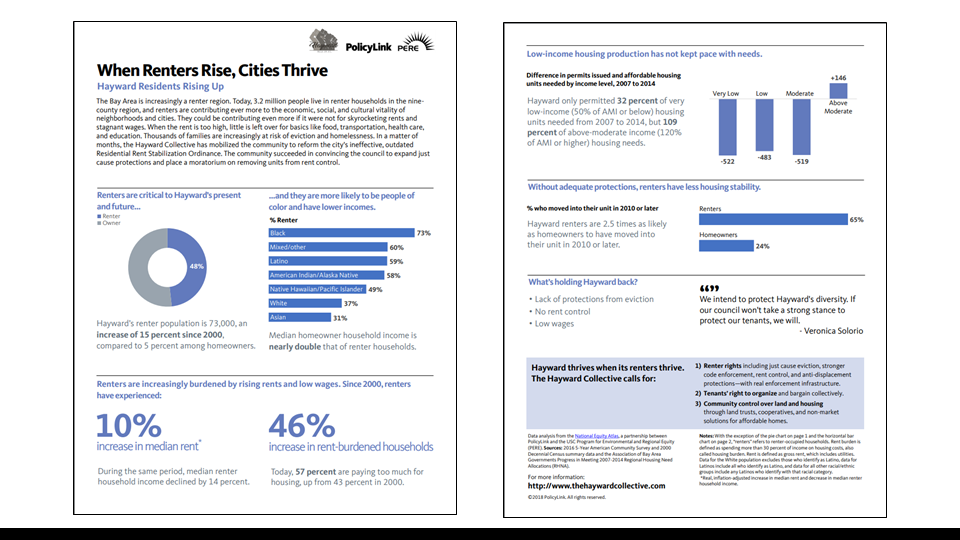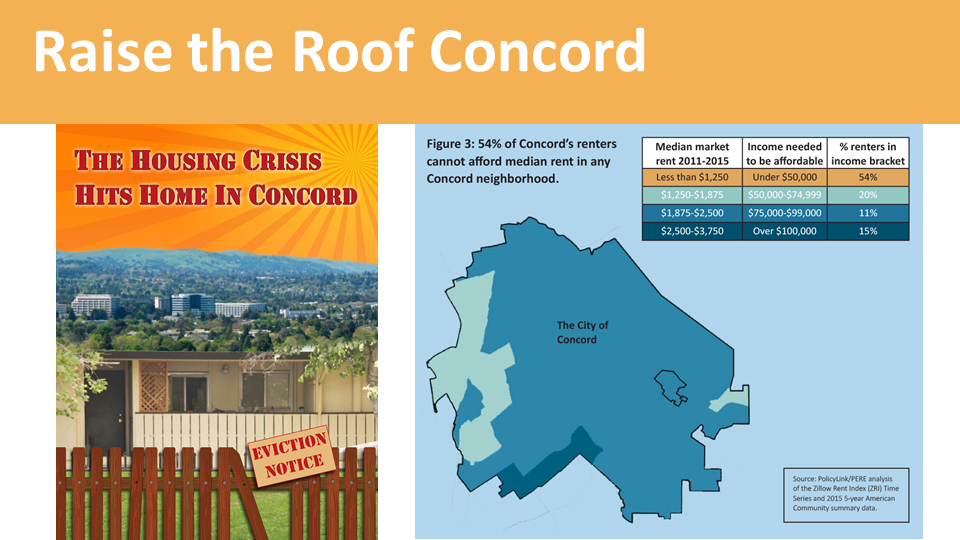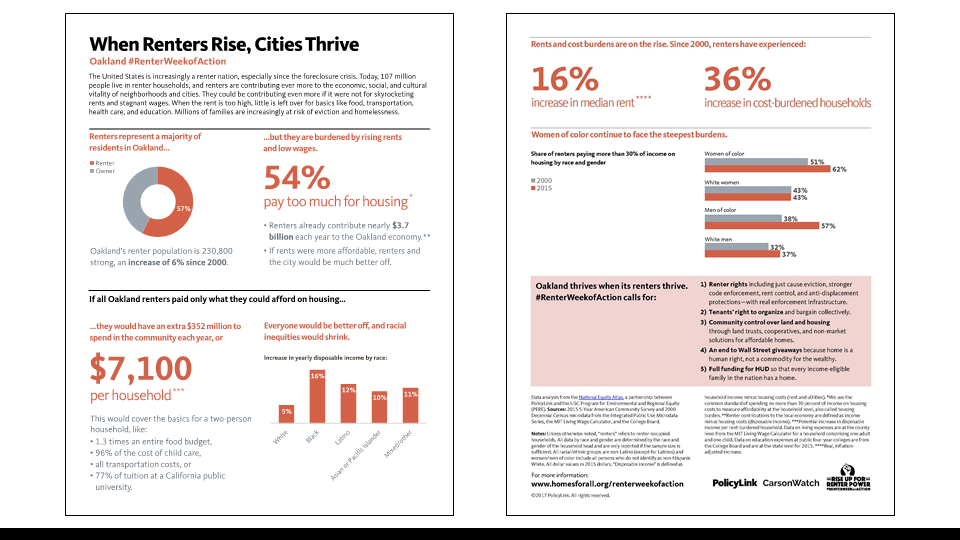Amidst the housing crisis, protecting Bay Area renters from eviction and excessive rent increases is critical to advancing equity, and data is an important ingredient in successful tenant protections campaigns. On July 23, 2019, the Atlas team hosted a webinar where advocates working to protect renters living in Concord, Hayward, Oakland, and San José shared how data fits into their strategy, and the team highlighted relevant Atlas data on the renter crisis. Here is a recap:
Hayward: Bolstering Tenant Stories with Equity Data to Strengthen Eviction Protections and Rent Stabilization
Alicia G. Lawrence, a volunteer housing justice organizer with The Hayward Collective, described how data on Hayward’s renter crisis compiled by the Bay Area Equity Atlas team helped fuel their tenant protections policy campaign, which began in Fall of 2018.
Hayward is the sixth largest city in the Bay Area, and one of the region’s most diverse, with 40 percent of residents identifying as Latinx. The Atlas team worked with The Hayward Collective to create a fact sheet highlighting how renters are animportant and growing constituency in the city. We found that 48 percent of residents now rent, including large majorities of Latinx, Black, Native American, and mixed race residents. But they are being financially squeezed because rents have increased 10 percent since 2000 while renter incomes have declined by 14 percent. As of 2015, 57 percent of Hayward tenants paid unaffordable rent, up from 43 percent in 2000.
The data helped validate the Collective’s claims about the renter crisis: “We knew what was happening and center lived experience but we can’t drive policy on lived experience alone, and we didn’t have the data.” The fact sheet helped the advocates educate high-level city officials about how renter protections help advance racial equity, since people of color are most impacted by ineffective rent stabilization. And the data on declining incomes helped to counter the landlord association’s claim that rents were not rising too quickly.
A year and a half later, the coalition has successfully won a new just cause policy protecting all Hayward renters from evictions as well as a new rent stabilization ordinance that brings 9,500 homes back under regulation, requires landlords to file rent increase and eviction notices with the city, and protects Section 8 voucher holders from discrimination. The Collective continues to work toward a stronger rent control ordinance that sets clear limits on annual rent increases, versus the current ordinance which allows tenants to challenge annual rent increases of more than 5 percent.
Concord: Data Helps Raise the Profile of the Renter Crisis in the Majority-Owner Suburb
Kristi Laughlin, senior campaign director at EBASE, shared how the Raise the Roof coalition included data created by the Bay Area Equity Atlas team in a report that helped build the case for rent control and tenant protections in Concord.
The faith, labor, and community coalition began working on tenant protections in Concord in 2016, after renters living in the racially-diverse Monument community began staging rent strikes in response to consecutive rent increases and unsafe living conditions. Their first campaign was for a moratorium to ban rent increases above three percent as well as no-cause evictions.
After the City voted against the rent freeze, with the mayor saying that there was not enough data to justify the policy, the coalition began gathering more data to corroborate tenants’ stories. In 2018, they released The Housing Crisis Hits Home in Concord with data from survey of nearly 1,000 residents, in-depth interviews, and secondary data on the housing crisis. The Atlas team contributed a map showing how the majority of Concord renters have annual household incomes below $50,000, yet there are no neighborhoods in the city with median market rents affordable to families with that income.
Laughlin says that “The combination of data and organizing was an important strategy that increased public opinion and garnered visibility.” The report helped raise the profile of Concord, received a lot of media attention, and helped educate potential allies on the reality of renters in Concord.
Despite successfully elevating the issue into the policy debate, Concord’s tenants are still awaiting stronger protections. In July, the city council decided not to move forward with just cause or rent stabilization. Laughlin said that the challenge in the majority-homeowner suburb is political will and the coalition continues to build the support needed to win.
San José: Leveraging Data to Shape the Narrative and Gain Media Attention
Jeffrey Buchanan, the director of public policy at Working Partnerships USA described how data has been a crucial ingredient in all of their campaigns to prevent displacement and strengthen renters’ rights in the city of San José and across Silicon Valley.
“Data is helpful in shaping narratives and can add to the power of organizing we are doing with tenants,” he explains. Numbers can paint a clear picture of who is being harmed by unjust policies and who is benefitting, serving as an important complement to organizing. And, data can gain earned media attention that spotlights injustice and compels action.
For example, data helped them finally win a just cause eviction ordinance in 2017. Working Partnerships analyzed who owns rental housing in San José and found that 75 percent of rental properties are owned by wealthy, absentee landlords. This data point helped them counter the landlord association’s narrative that mom and pop landlords would suffer from eviction protections and gain political support for the policy.
And in 2018, Bay Area Equity Atlas data helped them stave off the adoption of a policy that would have allowed landlords to raise rents by passing additional utilities costs through to renters. The Atlas team provided data showing that if San José renters paid only what they could afford on housing, households that are currently rent-burdened would have an additional $8,500 per year on average to spend on other household needs and in the local economy. This data point helped the coalition make the case that protecting renters boosts the local economy and reduces racial and gender inequity.
Oakland: Data Helps Pave the Way to Close Loopholes in Oakland’s Rent Stabilization Ordinance
Camilo Sol Zamora, acting deputy director at Causa Justa :: Just Cause described how data has come to play a larger role in their campaigns to protect Oakland tenants from landlord harassment, unfair evictions, and rent hikes.
This June, Oakland tenants won a historic victory when city council unanimously voted to stop exempting owner-occupied duplexes and triplexes from its rent stabilization program. Closing this loophole immediately provided greater housing security to more than 5,000 renters living in such properties, and ensured that 27,000 Oakland renters will not lose protections if the landlord moves into their building.
Testimonials of renters like Arcelia, whose landlord tried to use the exemption to raise her rent from $825 to $1,800, which she would not be able to pay on her fixed income, were key to closing the loophole, but Zamora explained how data served as an important complement. “With elected leadership, it wasn’t enough to just tell the stories, we had to package and sell them with the data,” said Zamora. (See the infographic they created for the loopholes campaign here).
Zamora said that the Oakland #RenterWeekofAction fact sheet developed by the Atlas team in partnership with the Right to the City Alliance was a “turning moment” in terms of integrating data into their campaigns. Since then, he says they’ve become savvier in terms of gathering and tracking data to use in their policy advocacy.
Renter Data in the Bay Area Equity Atlas
The Bay Area Equity Atlas puts powerful data on gentrification and the renter crisis at your fingertips so you can learn who is most impacted and use the data in your work to advance solutions.
On the webinar, I walked through the four key indicators related to the renter crisis that are available on the Atlas:
Please check out the webinar recording to hear more from our speakers and watch the demo (at about 41:00), and download the slides and additional resources shared by the speakers here. We’d love to hear how you are using this data in your work, and you can also contact us with your questions. You can reach the team at info@bayareaequityatlas.org.





